
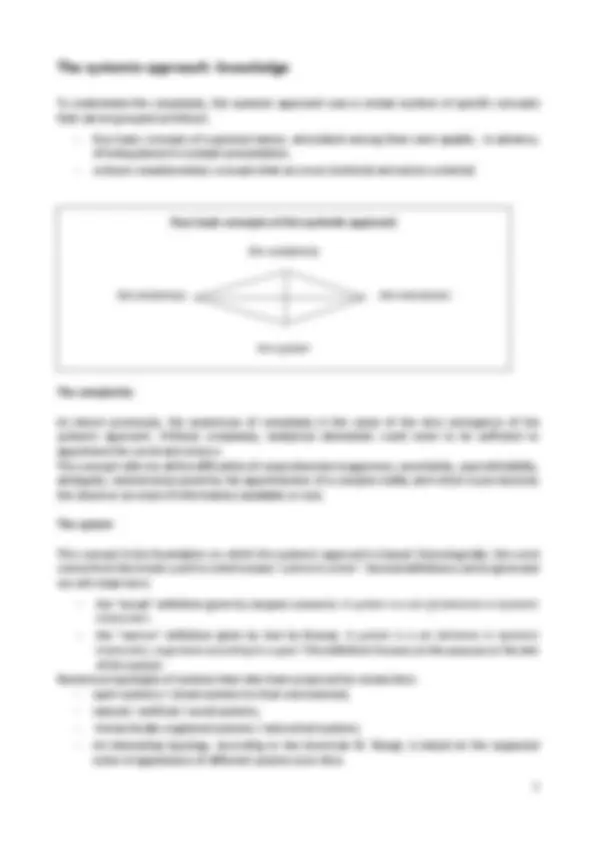
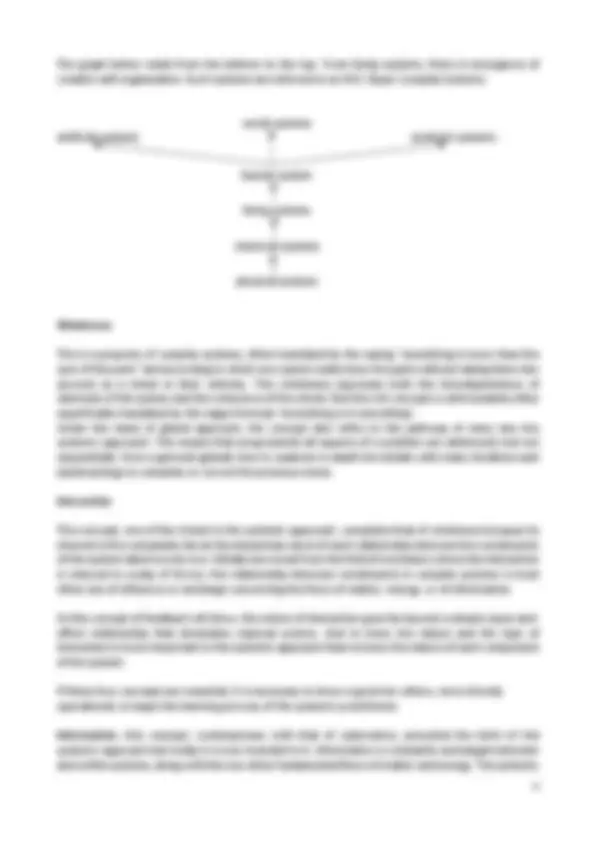
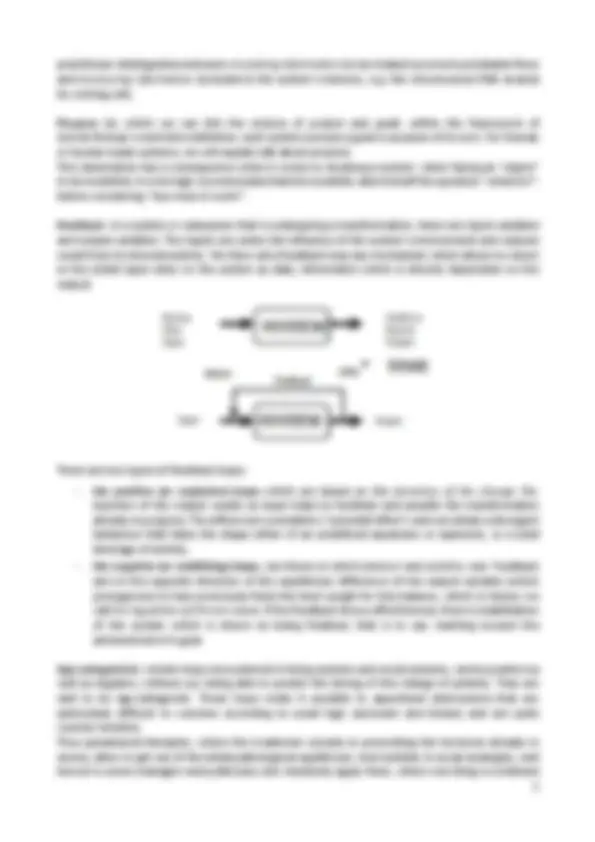
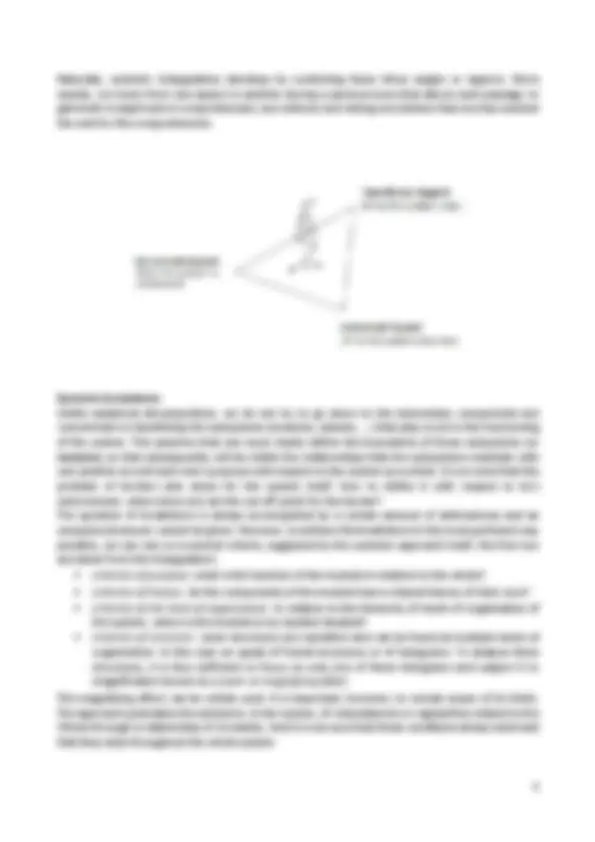

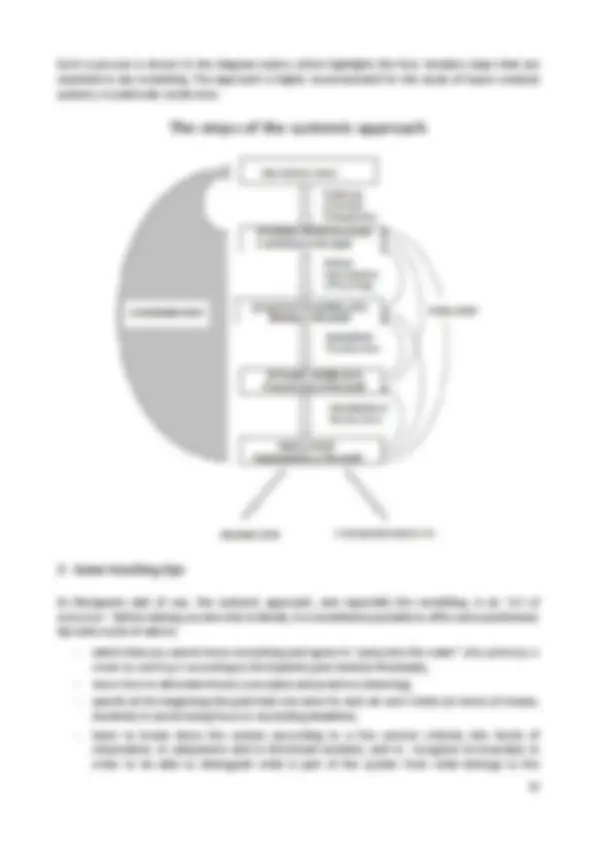


Study with the several resources on Docsity

Earn points by helping other students or get them with a premium plan


Prepare for your exams
Study with the several resources on Docsity

Earn points to download
Earn points by helping other students or get them with a premium plan
Community
Ask the community for help and clear up your study doubts
Discover the best universities in your country according to Docsity users
Free resources
Download our free guides on studying techniques, anxiety management strategies, and thesis advice from Docsity tutors
This Cartesian method is perfectly adapted to the study of stable systems consisting of a limited number of elements with linear interactions (i.e. which can be ...
Typology: Study Guides, Projects, Research
1 / 11

This page cannot be seen from the preview
Don't miss anything!







(Gérard Donnadieu, Daniel Durand, Danièle Neel, Emmanuel Nunez, Lionel Saint-Paul)
The great intellectual adventure of the end of the 20th century was the discovery of the extraordinary complexity of the world that surrounds us. The complexity concerns the cosmos, living organisms, human societies, but also all the artificial systems conceived and designed by people. These latter systems are, as is an economic enterprise, of technical, organizational, economic and social workmanship. The phenomenon of globalization of trade, whether commercial, financial or cultural, only accelerates this awareness of complexity and accentuates its effects. Certainly, complexity has always existed even though its perception is recent. For a long time, in their quest for knowledge and wisdom, humankind sought out only simple and logical explanations for the luxuriance of the world. This was first the agenda of philosophy then, in modern times that of positive science based on the Cartesian method and characterized by the attempt to reduce complexity to its elementary components. A fabulous method, by the way, since it is at the origin of the great progress made by science during the 19th and 20th centuries. This Cartesian method is perfectly adapted to the study of stable systems consisting of a limited number of elements with linear interactions (i.e. which can be described by continuous and additive mathematical laws) but it is no longer suitable when considering organized complexity as encountered in large biological, economic and social systems. Another approach is thus required, based on new representations of reality taking into account various occurrences of instability, openness, fluctuation, chaos, disorder, vagueness, creativity, contradiction, ambiguity, paradox. All these aspects that were once perceived as non-scientific by the prevailing positivism, are now considered as prerequisites for understanding the complexity of the real world. "If we do not change the way we think, we will not be able to solve the problems we create with our current ways of thinking" , said Albert Einstein. This new way of thinking has a name: the systemic approach.
The systemic approach first arose in the United States in the early 1950s. It arrived and has been practiced in France since the 1970s. The systemic approach opens an original and promising path for research and for action. Its approach has already given rise to many applications in various fields: biology, ecology, economics, family therapy, business organisational management, town planning, land use planning, etc. It is based on the concrete apprehension of a number of concepts such as: system, interaction, feedback, regulation, organization, purpose, global vision, evolution, etc. It takes shape in the process of modelling, which makes extensive use of graphical language and goes from qualitative model development, in the form of "maps", to the construction of dynamic and quantified models, operable on computers and leading to simulation. This is why the implementation of this approach requires a conceptual and practical learning effort that must be agreed upon by all (researchers, decision-makers, professionals and politicians, people of action but also simple citizens who want to understand their era) and who aspire to make a happy dive into complexity, in order to first orient themselves and then in a second time to be able to act on it.
Constantly combining awareness and action, the systemic approach is presented as the indissoluble alliance of knowledge and practices.
Taking into account the above summary graph will lead us very logically to present the systemic approach in of two parts:
But before we get to those two parts, the graph will have allowed us to understand the attempt at defining the systemic approach, without a doubt a little convoluted, given by the AFSCET (French Association of Sciences of the Cybernetic, Cognitive and Technical Systems), a reminder of which appeared in 1994 in the International Journal of the Systemic Approach ( Revue Internationale de Systémique ).
Definition of the systemic approach : New discipline which brings together theoretical, practical, and methodological approaches, relating to the study of what is recognized as too complex to be approached in a reductionist way, and which poses the problems of borders, internal and external relationships, structures, laws or emerging properties characterizing the system as such, or the problems of: mode of observation, representation, modelling or simulation of a complex totality.
tools
triangulation analogy breakdown
graphical language
modelling/simulation
Systemic Approach Practices
Systemic Approach Knowledge
4 basic concepts
complexity
wholeness interaction system
an approach prudent, ambitious
A learning process some advice :
other concepts variety purpose, project information
level of organisation feedback regulation openness / closure response time black box
The graph below reads from the bottom to the top. From living systems, there is emergence of creative self-organization. Such systems are referred to as HCS: Hyper Complex Systems.
social systems artificial systems symbolic systems
human system
living systems
chemical systems
physical systems
Wholeness
This is a property of complex systems, often translated by the saying "everything is more than the sum of the parts "and according to which one cannot really know the parts without taking them into account as a whole in their entirety. This wholeness expresses both the interdependence of elements of the system and the coherence of the whole. But this rich concept is unfortunately often superficially translated by the vague formula "everything is in everything". Under the name of global approach, the concept also refers to the pathway of entry into the systemic approach. This means that progressively all aspects of a problem are addressed, but not sequentially: from a general (global) view to examine in depth the details with many iterations and backtrackings to complete or correct the previous vision.
Interaction
This concept, one of the richest in the systemic approach, completes that of wholeness because its interest in the complexity lies at the elementary level of each relationship between the constituents of the system taken two by two. Initially borrowed from the field of mechanics where the interaction is reduced to a play of forces, the relationship between constituents in complex systems is most often one of influence or exchange concerning the flows of matter, energy, or of information.
As the concept of feedback will show, the notion of interaction goes far beyond a simple cause-and- effect relationship that dominates classical science. And to know the nature and the type of interaction is more important in the systemic approach than to know the nature of each component of the system.
If these four concepts are essential, it is necessary to know a good ten others, more directly operational, to begin the learning process of the systemic practitioner.
Information : this concept, contemporary with that of cybernetics, preceded the birth of the systemic approach but today it is now included in it. Information is constantly exchanged between and within systems, along with the two other fundamental flows of matter and energy. The systemic
practitioner distinguishes between circulating information (to be treated as a mere perishable flow) and structuring information (included in the system’s memory, e.g. the chromosome DNA strands for a living cell).
Purpose (to which we can link the notions of project and goal): within the framework of Joel de Rosnay‘s restrictive definition, each system pursues a goal or purpose of its own. For Human or human-made systems, we will equally talk about projects. This observation has a consequence when it comes to studying a system: when facing an "object" to be modelled, it is strongly recommended that the modeller asks himself the question "what for?" before wondering "how does it work?".
Feedback : in a system or subsystem that is undergoing a transformation, there are input variables and output variables. The inputs are under the influence of the system’s environment and outputs result from its internal activity. We then call a feedback loop any mechanism which allows to return to the initial input entry to the system as data, information which is directly dependent on the output.
There are two types of feedback loops:
Ago-antagonism : certain loops encountered in living systems and social systems, can be positive as well as negative, without our being able to predict the timing of this change of polarity. They are said to be ago-antagonist. These loops make it possible to apprehend phenomena that are particularly difficult to conceive according to usual logic (exclusive and binary) and are quite counter-intuitive. Thus paradoxical therapies, where the treatment consists in prescribing the hormone already in excess, allow to get out of the initial pathological equilibrium. And similarly in social strategies, well known to some managers and politicians who intuitively apply them, where one thing is combined
Synchronism and diachrony : synchronous behaviours (movements that occur at the same time) of a system are those which are observed during a structural level or stage (where there is an absence of evolution of the structure). It is more difficult to understand the dynamics of evolution, or diachrony, because it is not only historical but it may also include a "possible" and prospective dimension. A good method is to first examine the diachronic aspect and to make note of the successive synchronic stages.
The Systemic approach: a method
The systemic approach is not only knowledge, but also practices, a way to enter into the complexity. The pedagogy to be implemented must be innovative both in its general approach and in the tools used.
The approach takes place in stages: observation of the system by various observers and from various angles or aspects; analysis of interactions and regulatory chains; modelling that takes into account the lessons learned from the evolution of the system; simulation and confrontation to reality (experimentation) to obtain a consensus. Such an approach must be both prudent and ambitious:
We will present three basic tools, before touching on the graphical language which is the natural language of the systemic approach, followed by the presentation of modelling that, better than a tool, is at the heart of the Systemic Approach.
Systemic triangulation Remarkably adapted to the investigation phase of a complex system, the triangulation will observe the system from three different but complementary aspects, each linked to a particular point of view of the observer.
The functional aspect is especially focused on the purpose or the goals of the system. Spontaneously we try to answer the questions: what does the system do in its environment? What is it used for? The structural aspect aims to describe the structure of the system, the arrangement of its various components. Here we find the analytical approach with however a weighty nuance: the emphasis is much more on the relationships between components than on the components themselves, on the structure rather than on the element. The historical (or genetic or dynamic) aspect is related to the evolutionary nature of the system, with a memory and a project, capable of self-organization. Alone, the history of the system will quite often reflect some of the aspects of how it operates. For social systems, it is through their way of functioning that it is best to begin the observation.
Naturally, systemic triangulation develops by combining these three angles or aspects. More exactly, we move from one aspect to another during a spiral process that allows each passage, to gain both in depth and in comprehension, but without ever letting one believe that one has reached the end for this comprehension.
Systemic breakdown Unlike analytical decomposition, we do not try to go down to the elementary components but concentrate on identifying the subsystems (modules, subsets, ...) that play a role in the functioning of the system. This assumes that one must clearly define the boundaries of these subsystems (or modules ) so that subsequently will be visible the relationships that the subsystems maintain with one another as well each one’s purpose with respect to the system as a whole. It is to note that this problem of borders also arises for the system itself: how to define it with respect to its’s environment, where does one set the cut-off point for the border? The question of breakdown is always accompanied by a certain amount of arbitrariness and an unequivocal answer cannot be given. However, to achieve the breakdown in the most pertinent way possible, we can rely on a several criteria, suggested by the systemic approach itself, the first two are taken from the triangulation: criterion of purpose : what is the function of the module in relation to the whole? criterion of history: do the components of the module have a shared history of their own? criterion of the level of organization: in relation to the hierarchy of levels of organization of the system, where is the module to be studied situated? criterion of structure: some structures are repetitive and can be found at multiple levels of organization. In this case we speak of fractal structures or of holograms. To analyse these structures, it is thus sufficient to focus on only one of these holograms and subject it to magnification known as a zoom or magnifying effect.
This magnifying effect can be widely used. It is important, however, to remain aware of its limits. The approach postulates the existence, in the system, of redundancies or regularities related to the Whole through a relationship of circularity. And it is not sure that these conditions always exist and that they exist throughout the whole system.
Such a process is shown in the diagram below which highlights the four iterative steps that are essential to any modelling. The approach is highly recommended for the study of hyper-complex systems, in particular social ones.
The steps of the systemic approach
As Bonaparte said of war, the systemic approach, and especially the modelling, is an " art of execution ". Before letting you dive into it blindly, it is nonetheless possible to offer some preliminary tips and words of advice:
environment, do as many iterations as necessary to avoid the pitfalls of linearity, and at lease to ensure functional/structural coherence, global/local, synchronic/diachronic and external vision/internal vision,
To conclude
If we were to characterize, in a few words, the systemic approach with respect to the traditional analytical approach inherited from Descartes is in reality very much more complementary than opposed, we could say that it is:
An effective instrument to try to understand how a living cell works, the human body, an economic enterprise, the economy, the society, the systemic approach is particularly suited to do so in order to inform and guide the action of decision-makers, whoever they may be: politicians, business leaders, trade unionists, experts, heads of associations, etc. The systemic approach is also able to provide the "honest person" of our time (one who seeks to understand and situate one’s self) with the keys for understanding the world in which he lives. Effective content can thus be given to the formulas that describe the remedies that our society needs (participation, decentralization, communication, citizenship, etc.) but because our society lacks rigorous concepts and appropriate methodology, those needs remain unfulfilled like a useless piece of paper or a dead letter.
Bibliography : Daniel Durand, La systémique, PUF "Que sais-je?" No. 1795, 1979 Gérard Donnadieu & Michel Karsky, La systémique: penser et agir dans la complexité , Liaisons, 2002 Joël de Rosnay, Le macroscope , Seuil, 1975 ( The macroscope : A new scientific system , Harper & Row, 1979) September 2003
Original title : L'Approche systémique : de quoi s'agit-il ?, Synthèse des travaux du Groupe AFSCET, "Diffusion de la pensée systémique", (Gérard Donnadieu, Daniel Durand, Danièle Neel, Emmanuel Nunez, Lionel Saint-Paul), 2003. English version proposed by Elizabeth Devlin-Couvert, December 2017.